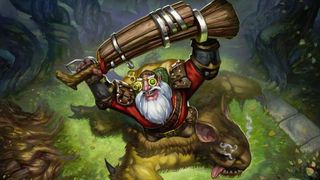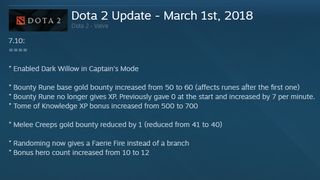Dota 2's new rapid update schedule is a positive step for a maturing game
Making a game about chaos more reliable.

We are deep into Dota 2's mature years. Valve's superlative wizard-clicker left beta almost half a decade ago, and it's been 18 months since it finally achieved parity with (and subsequently overtook) the original Defense of the Ancients mod. Last year saw it unseated from its permanent spot at the top of the Steam charts—and not just unseated but utterly routed, the vast success of PUBG relegating it to distant second place.
It's important to contextualise 'second place'. Dota 2 has lost a few hundred thousand players, but is still comfortably more popular than CS:GO and significantly more popular than the vast majority of games on Steam (and that's a lot of games). It still has more players than six of the ten most popular Steam games combined, a list that includes Rainbow 6: Siege, Grand Theft Auto V, and Warframe. If this deep, strange, ruthlessly difficult game is becoming niche, then, it's still a really big niche.
As long as Dota 2 retains enough players to be viable, a shrinking community is not necessarily a concern: after all, this game has never particularly concerned itself with growth. If it did, it'd be less weird. Other developers have found ways to make DotA's fundamentals more accessible, but Dota 2's guiding star has always been the original mod's community-grown strangeness. As custodians of that strangeness, Valve has taken steps to make Dota 2 more approachable and more contemporary in its presentation. They've made Dota 2 more coherent, if not much more accessible, and this is appropriate as the game's community settles.

If Dota 2 is about anything it's about your ability, individually and a team, to adapt to a complicated and ever-changing strategic situation.
Dota 2's new update schedule, which sees a patch deployed every other Thursday, is a small but significant change that helps build upon the best things about Valve's management of the game—and protect against the mistakes they have frequently made. By comparison to other MOBAs, Dota 2 has traditionally been updated infrequently but suddenly. Valve doesn't talk much, IceFrog less so, and as such the arrival of a game-upending patch is often a surprise: a shock that sends analysts scrambling for their video cameras.
There's always been something exciting about the moment when a patch arrives, but the wait between them can be interminable: and with no fixed schedule, the Dota 2 community has endured long periods where very little seemed to be happening at all. This breeds discontent. If Dota 2 is about anything it's about your ability, individually and a team, to adapt to a complicated and ever-changing strategic situation. I'd argue that this is true of the game in a broader sense, too: what keeps people playing over the course of years is the challenge of developing your understanding of a sandbox that never stops moving. In the long wait between updates, however, both momentum and player enthusiasm can fade. A sort of metagame ennui sets in, with players locked into a playbook according to their skill level. Playbooks aren't Dota: setting playbooks on fire is Dota.
Valve didn't invent the concept of the fortnightly update, but if they're going to take any pages out of the League of Legends playbook I'm glad it's this one. Communication has always been a weakness of theirs: they don't employ community teams or PR agencies, and it seems unlikely that their company culture would ever allow that to change. Guaranteeing a patch every two weeks helps get around some of those issues because the most frequent question a hypothetical Dota 2 community manager would have to field would inevitably be 'when's the patch'. And Valve has always preferred to communicate via patch note: more patches is effectively more communication, albeit in their own specific mechanical way.

With a more manageable rate of change comes more manageable updates. The updates deployed in this way so far have felt, appropriately, like patches in miniature—far less extensive than the overhauls of old, but providing welcome balance adjustments that are well communicated through a new feature that highlights changes to heroes and abilities within the game itself. Dota 2 has always been at its best in the uncertain weeks following a patch, and while these latest updates have been less world-changing than the community might be used to, there's a fresh sense that the metagame is always on the edge of a change.
The biggest gaming news, reviews and hardware deals
Keep up to date with the most important stories and the best deals, as picked by the PC Gamer team.
This is good for Dota 2, and rewards players who are good at parsing the current state of the metagame and coming up with creative ways to break it open—a narrow community, but a skill that every Dota player can aspire to learn. For everybody else, more regular changes means that there's a fixed term attached to on any given flavour-of-the-month hero pick or strategy.
Perhaps given time the community will get used to this new rate of change and miss the days when you suddenly had to relearn whole swathes of the game: in the meantime, it's nice to be able to load Dota 2 and discover that something interesting has changed. 'Reliability' is a strange concept to apply to a game about managing chaos, but Valve is taking the right steps to make sure that this deeply weird, fascinating game reliably shows its best side. Will that help it reclaim the thousands of players lost to PUBG's wildernesses? Probably not. Is it the right approach for the hundreds of thousands that remain? Yes.
Joining in 2011, Chris made his start with PC Gamer turning beautiful trees into magazines, first as a writer and later as deputy editor. Once PCG's reluctant MMO champion , his discovery of Dota 2 in 2012 led him to much darker, stranger places. In 2015, Chris became the editor of PC Gamer Pro, overseeing our online coverage of competitive gaming and esports. He left in 2017, and can be now found making games and recording the Crate & Crowbar podcast.
Most Popular


